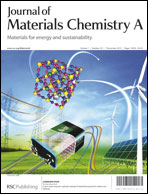Highly photoactive anatase nanoparticles obtained using trifluoroacetic acid as an electron scavenger and morphological control agent†
Abstract
Fluorine species adsorbed on the surface of TiO2 anatase nanoparticles improve their photocatalytic performance by reducing the recombination rate of photogenerated electrons and holes. Trifluoroacetic acid (TFAA) has been recently proposed as a promising harmless substitute for hydrofluoric acid (HF) in preparing fluorine-modified anatase with good scavenger properties. However the photocatalytic performance of the TiO2 nanoparticles also depends on their specific morphology, by which the number and type of crystal facets, which remain exposed, are determined. A comprehensive study is presented in this contribution which for the first time describes the role of TFAA in stabilizing the highly photoactive {001} TiO2 facets. Furthermore, by reducing the amount of water incorporated into the reaction medium, a simple one-step synthesis method is also proposed that allows the preparation of TFAA-modified anatase nanoparticles with specific morphology and selected stabilized facets, eventually yielding a semiconductor material with excellent photocatalytic properties.


 Please wait while we load your content...
Please wait while we load your content...